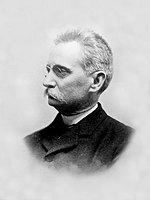How to Pronounce Lluís Domènech i Montaner
#50
Most Popular
Boost
Dec 21, 1850 Barcelona, Catalonia, Spain Died on 27 Dec 1923 (aged 73)
Spanish architect and politician
SagittariusLluís Domènech I Montaner, Date of Birth, Place of Birth, Family, Facts, Age, Net Worth, Biography and More in FamedBorn.com

Spanish architect and politician
Sagittarius